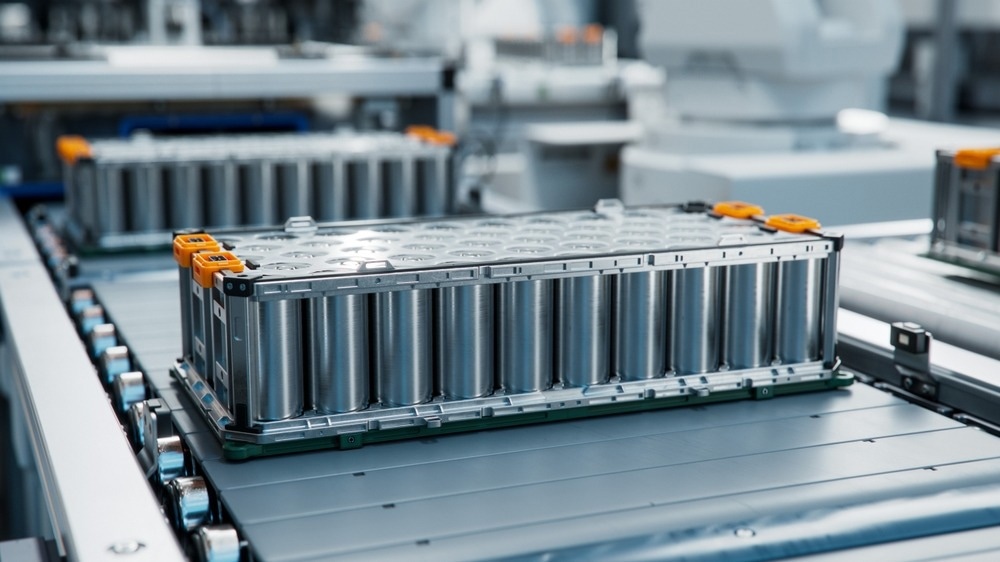A recent study published in Nature Communications proposed a composite polymer electrolyte (CPE) locally tethered with rationally designed Hofmann-N,N-dimethylformamide (DMF). The researchers aimed to simultaneously improve the electrolyte’s ionic conductivity and electrochemical stability, enabling its commercial application in next-generation batteries.

Image Credit: IM Imagery/Shutterstock.com
Background
Solid polymer electrolytes (SPEs) are promising for future solid-state batteries because of their high safety and accessible processability.
However, the sluggish segmental motion and low solvability of the polymer matrix result in insufficient room-temperature ionic conductivity of SPEs (10-8 to 10-5 S cm-1). Thus, high-dielectric solvents like DMF are utilized as plasticizers in SPEs to improve transport kinetics and boost ionic conductivity.
However, using DMF-containing electrolytes in solid-state batteries is challenging due to poor cycle life caused by continuous DMF degradation at the anode surface, which results in unstable solid-electrolyte interphase (SEI). Such uncontrolled decomposition and depletion of DMF are highly unfavorable for the stability of the Li anode and the durability of SPEs.
Additive engineering offers a low-cost and practical approach to mitigate the undesirable effects of DMF in SPEs. However, previous approaches have mainly addressed ionic conductivity or electrochemical stability.
The synergetic effect of DMF modulation and Li+ transport remains unclear, hindering the design of efficiently functional and durable polymer electrolytes. This study used a composite polymer electrolyte with a rationally designed Hofmann-DMF coordination complex to improve both ionic conductivity and electrochemical stability.
Methods
In the present study, the researchers proposed a DMF-containing coordination complex as a dual-functional additive. Since layered Hofmann-framework materials offer metal site-rich features and tunable geometry by incorporating appropriate ligands, DMF was engineered on Hofmann frameworks. This created a locally confined DMF-rich environment at additive-polymer interfaces of CPEs (Ni(DMF)2Ni[CN]4, denoted as Ni-DMF).
During the synthesis of Ni-DMF, the samples at each step were thoroughly characterized by several techniques, including scanning electron microscopy, transmission electron microscopy, scanning transmission X-Ray microscopy, X-Ray diffraction, and Fourier transform infrared spectroscopy.
To investigate the ionic conduction of Ni-DMF, the materials were incorporated into a lithium bis(fluorosulfonyl)imide/poly(vinylidene fluoride-co-hexafluoropropylene) (LiFSI/PVDF-HFP) electrolyte (LPE) to yield a CPE (LPE@Ni-DMF). It was further used to prepare SSE membranes through a solution-casting method.
The DMF corrosion procedure on Li metal and the in situ reactivity between DMF and Li metal in these membranes were investigated using an optical microscope.
The as-prepared LPE and LPE@Ni-DMF membranes were then cut into disks with different diameters for electrochemical measurements and incorporated into stainless steel (SS) symmetric SS | SSE | SS cells to test ionic conductivities at 25 °C, 20 °C, 10 °C, 0 °C, and -10 °C.
Thermogravimetric analysis was conducted to probe the thermal stability of SSE and determine the weight variation of DMF before and after electrochemical tests. A film stress measurement system tested the membrane’s mechanical performance, and Raman spectra detected the ionic states.
Classical molecular dynamics (MD) simulations were performed to obtain the ionic conduction mechanism of the LPE and LPE@Ni-DMF using the large-scale atomic/molecular massively parallel simulator (LAMMPS) software package.
Finite element analysis was performed using the COMSOL Multiphysics 6.0 platform for the process of DMF corroding the Li anode and the Li+ electrochemical behavior under different SEIs.
Results
The incorporation of DMF ligand-exchanged Hofmann frameworks simultaneously improved ionic conductivity and electrochemical stability for CPEs. The locally DMF-rich interface promotes Li+ conduction through a ligand-assisted transport mechanism, enhancing room-temperature ionic conductivity to 6.5 × 10-4 S cm-1.
These surface-tethered DMF ligands also facilitate ion transport by a locally solvent-rich environment while minimizing undesirable DMF migration.
The locally solvent-tethered electrolyte cycled stably for over 6000 hours at 0.1 mA cm-2 in Li| |Li symmetric cells with an overvoltage of 64 mV. It effectively reduced the free shuttling and subsequent decomposition of DMF. This can be attributed to the confinement and lower consumption of DMF, leading to a stable SEI with notably decreased DMF-induced products and a durable CPE.
When paired with sulfurized polyacrylonitrile cathodes, the full cell exhibited a prolonged cycle life of 1000 cycles at 1 C.
Ni-DMF helps immobilize anions and demonstrates a high Li+ transference number. These features allow Li|sulfurized polyacrylonitrile cells to function for 1000 cycles at 1 C with a capacity decay of 0.04 % per cycle and a pouch cell with an aerial capacity of 1.9 mAh cm-2 (47 mAh with 50 mg sulfur loading) to operate for 35 cycles.
These results demonstrate the exceptional performance potential of the proposed electrolyte in solid-state lithium-sulfur batteries (ssLSBs).
Conclusion
The proposed locally solvent-tethered polymer electrolyte design resulted in highly ion-conductive and durable CPEs with the dual-functional Ni-DMF additive. The confinement effect of Ni-DMF prevents DMF consumption, resulting in enhanced durability for both the CPE and Li metal anode.
Ni-DMF provides a locally DMF-rich interface for Li+ transport, improving ionic conductivities at both room temperature and extreme operating conditions. The Achilles’ heel of solvent-containing SPEs was also effectively addressed, which is crucial for achieving stable cycling performance in ssLSBs.
Thus, this study demonstrates a promising CPE design for the potential application of ssLSBs, which can be extended to SPEs for other emerging solid-state battery systems. It may facilitate the development of practical polymer-based electrolytes with high ionic conductivity and long cycle life.
Journal Reference
Zhu, Y., et al. (2024). A locally solvent-tethered polymer electrolyte for long-life lithium metal batteries. Nature Communications. doi.org/10.1038/s41467-024-48078-7
Disclaimer: The views expressed here are those of the author expressed in their private capacity and do not necessarily represent the views of AZoM.com Limited T/A AZoNetwork the owner and operator of this website. This disclaimer forms part of the Terms and conditions of use of this website.